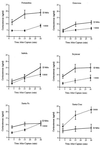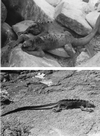Corticosterone levels predict survival probabilities of Galapagos marine iguanas during El Nino events
- PMID: 11416210
- PMCID: PMC34674
- DOI: 10.1073/pnas.131091498
Corticosterone levels predict survival probabilities of Galapagos marine iguanas during El Nino events
Abstract
Plasma levels of corticosterone are often used as a measure of "stress" in wild animal populations. However, we lack conclusive evidence that different stress levels reflect different survival probabilities between populations. Galápagos marine iguanas offer an ideal test case because island populations are affected differently by recurring El Niño famine events, and population-level survival can be quantified by counting iguanas locally. We surveyed corticosterone levels in six populations during the 1998 El Niño famine and the 1999 La Niña feast period. Iguanas had higher baseline and handling stress-induced corticosterone concentrations during famine than feast conditions. Corticosterone levels differed between islands and predicted survival through an El Niño period. However, among individuals, baseline corticosterone was only elevated when body condition dropped below a critical threshold. Thus, the population-level corticosterone response was variable but nevertheless predicted overall population health. Our results lend support to the use of corticosterone as a rapid quantitative predictor of survival in wild animal populations.
Figures





References
-
- Romero L M, Reed J M, Wingfield J C. Gen Comp Endocrinol. 2000;118:113–122. - PubMed
-
- Wingfield J C, Romero L M. In: Handbook of Physiology: The Endocrine System. McEwen B S, Goodman H M, editors. IV. New York: Oxford Univ. Press; 2001. , Section 7, pp. 211–234.
-
- Sapolsky R M, Romero L M, Munck A U. Endocr Rev. 2000;21:55–89. - PubMed
-
- Wingfield J C, Hunt K, Breuner C, Dunlap K, Fowler G S, Freed L, Lepson J. In: Behavioral Approaches to Conservation in the Wild. Clemmons J R, Buchholz R, editors. Cambridge, U.K.: Cambridge Univ. Press; 1997. pp. 95–131.
-
- Dallman M F, Strack A M, Akana S F, Bradbury M J, Hanson E S, Scribner K A, Smith M. Front Neuroendocrinol. 1993;14:303–347. - PubMed
Publication types
MeSH terms
Substances
LinkOut - more resources
Full Text Sources

